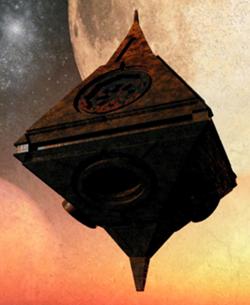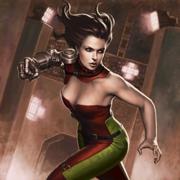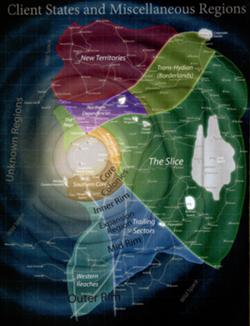Legends Galactic History 102: Origins of the Jedi Order
1. Introduction
Welcome back for those joining from another course in this series, or welcome in general to those making their first foray into the study of the history of the galaxy. Today’s topic of discussion is the formation of the Jedi Order, the Galactic Republic, and some of the earliest troubles of both. As with all other courses in this series, you will notice “Further Reading” sections spread throughout - while you won’t be tested on these, you’re encouraged to explore them to further your understanding of interesting people, places, or events.
2. Formation of the Jedi Order (36,453 BBY - 25,000 BBY)

The history of what we now know as the Jedi Order began more than 10,000 years before the creation of the Galactic Republic (the government many refer to as the “Old” Republic). Many of the greatest minds in the galaxy felt a pull by the pyramid ships called the Tho Yor. After which, in what became known as the First Migration, they were transported across the stars to the planet Tython. Eventually, these people - known as Tythans - came to call themselves the Je’daii Order, who existed to maintain a balance in the Force between the Ashla (or Light Side) and the Bogan (Dark Side).
This balance proved difficult, and around 25,793 BBY, adherents to the teachings of the two sides clashed in what we know as the Force Wars. The conflict raged across Tython for a decade, devastating the ecosystem and destroying the balance that had so long existed between the two sides of the Force. In the end, the followers of Ashla were victorious. Feeling their side was superior and more virtuous than the Bogan, they began calling themselves Jedi and selected some of the most revered followers to lead them on a ruling body known as the Jedi Council.
At the first creation of the Galactic Republic, the Jedi sought to avoid contact with the interplanetary government, fleeing to a lush world (very similar to Tython) called Ossus. It was there the Jedi secluded themselves, forming an academy on the planet where they deepened their meditations on the Ashla while warning others of the threats associated with the Bogan. The Galactic Republic’s desire for peace across the galaxy, however, was in keeping with the growing belief in justice and the greater good that the Jedi Order taught, so the Jedi agreed to join with the Republic while remaining isolated on Ossus.
Further reading:
* Tython
* Tho Yor
3. The First Great Schism (24,500 BBY)

As the Jedi established themselves on Ossus, the doctrine of the Jedi, set forth by the Jedi Council, became more entrenched and exclusionary. Some Jedi chafed at this encroachment on their freedom and strayed closer to the teachings of the Bogan. One disaffected Jedi, Xendor, petitioned the Council to allow him to establish a new academy away from Ossus where he could teach alternative philosophies relating to the Force.

When they denied his request, Xendor left the planet with a young Jedi named Arden Lyn and together they created their new academy. In what became known as the Great Schism (later known as the First Great Schism, as this was not the last), a number of Jedi left Ossus and joined with Xendor on the planet Lettow, where he established this alternate academy. The Jedi Council branded this new group the Legions of Lettow and raised an army to end it. In an attempt to end the war early, Xendor led his followers in an attack against Ossus which was repelled. From here, the conflict spread into Republic space, including the Republic capital of Coruscant. The Jedi Order (assisted by the Republic), was eventually victorious over the heretics, with one Jedi in particular - Awdrysta Pina - slaying Xendor and placing Lyn in a 24,000 year stasis. With both leaders of the Legions gone, the last survivors fled beyond the reaches of Republic space, and the threat was ended.
Further reading:
* Arden Lyn
4. The Tionese War and the Great Manifest Period (24,000 BBY - 17,018 BBY)
4.1 The Tionese War
Though they banded together to stop the Legions of Lettow, the Jedi Order largely maintained its isolation from the rest of the Republic, and the Republic, in turn, largely ignored the Order. It was because of this that when the Jedi repeatedly warned the Republic of the threat posed by remnants of Xim the Despot’s former empire, the Honorable Union of Desevro and Tion, the Republic disregarded the threat. When the Tionese invaded Republic space across the Perlemian Trade Route (a vital hyperspace trade land that connected the Republic with Ossus), the Jedi’s warnings were proven true, and the Republic was caught off guard, suffering early losses.
The Republic militarized and swung the full might of their forces against the Tionese, including the former Tionese allies, the Hutt Cartel. The Jedi Council, who at first had decided to sit out the war, gave in and joined the fight, with many Jedi serving as commanders in the Republic military. Even though the war was largely won by this point, the Republic felt the need to deliver a coup de grace, thus Republic forces on the planet Desevro (which served as a capital world for the Tionese) chose to sterilize the entire planet. This atrocity horrified the Jedi, who in response vowed to never serve the Republic. Instead, they would form a network of Jedi watch posts throughout the Perlemian to guard this important trade route. With the conclusion of the war, most of the planets previously a part of the Union joined the Republic.
Further reading:
* Jedi Watchmen
4.2 Expansionist Period
The Galactic Republic, at this point, had been in a period of growth (formally called the Expansionist Period) for more than 5,000 years. During this time, numerous planets and systems were added to the Republic. In an effort to control the exploding bureaucracy and ensure no one sector grew too large (and considered independence), the Republic had a policy in place called the Rule of Fifty that stated no more than fifty planets could exist in a single sector. However, as expansionist desires overwhelmed the logical reasoning behind the law, it was increasingly ignored. The Republic continued to induct more and more worlds farther from the Core Worlds, while the population of what became known as the “Slice” grew exponentially. The Slice was a huge, vaguely crescent shaped area of the galaxy (bordered on either side by the Corellian Run and the Perlemian Trade Route) that was home to the vast majority of the most important and well-known planets: Alderaan, Tatooine, Kessel, Mon Calamari, Nal Hutta, Onderon, and more.

Two planets dominated trade in the Slice: along the northern edge, Alsakan; along the southern edge, Corellia. The two trade superpowers constantly competed to gain control of as many worlds in the middle as possible. Near 17,000 BBY, Alsakan led a coalition along the Perlemian Trade Route in an effort to block the so-called Grand Companies - some of the most powerful trading companies in the Slice - from moving further into the southern, resource-rich area. Duros merchants, backed by the Republic, clashed with Alsakan warships in a series of battles known as the First Alsakan Conflict. The Republic emerged victorious in 16,700 BBY when their Bureau of Ships and Services - the ultra-powerful bureaucratic organization that regulated interstellar ships - threatened to withhold vital access to the entire network of hyperspace beacons from the Alsakan if they continued. Since the loss of that access would have been the death knell of Alsakan trade, they acquiesced. The conflict, however, had the lasting impact of bringing the Expansionist Period to an end and ushering in its place what historians refer to as the Indecta Era. This era was marked by small-scale strife - including further conflict centered around the Alsakans - as well as the use of assassin droids by the Judicial Department of the Republic.
Further reading:
* Alsakan Conflicts
5. The Hundred-Year Darkness (7,000 BBY - 6,900 BBY)
Following the end of the Expansionist Period, the Republic enjoyed almost 10,000 years of relative stability - there was fighting, of course, but nothing on a galactic scale. This changed in 7,003 BBY. In that year, a group of Jedi who had delved deep into their studies of the Force and its use in creating life, including those of the Legions of Lettow, began to chafe under the rule of the Jedi Council. Led by such now-infamous Jedi as Ajunta Pall, this sect was exiled from the main body and began the Second Great Schism.
This sect of fallen Jedi knew they were weaker than their former brethren, so they used Dark Side magic to create an army of abominations - such as Korriban zombies and the fearsome Leviathan - to fight by their side. Even with these monstrosities, however, the Dark Jedi were pushed back. Their final battle was fought on the planet Corbos, with heavy losses on the side of the Dark Jedi. The survivors were exiled from known Republic space and eventually ended up on the planets Korriban and Ziost - a momentous event in the history of what we now know as the Sith that will be covered in more detail in the next course in this sequence.
Further reading:
* Leviathan
6. Republic Government Structure
By the end of the Expansionist and Great Manifest Periods, the Galactic Republic as we know it had firmly established itself. The Republic was set up as a representative democracy - the definition, as a political scientist would point out, of a “republic”. Each sector, or group of planets, was represented in its legislative body, the Galactic Senate, by a single Senator. These Senators then elected a Supreme Chancellor who served as the executive of the Republic, charged with carrying out (or executing) its laws.
One of the problems with the Galactic Republic throughout its existence was the huge bureaucracy that bloated its inner workings. Simply put, nothing could happen swiftly if the Republic government was involved. Everything had to be debated and discussed at numerous levels throughout the government. However, when things could work through the bureaucratic morass, the Republic was capable of incredible feats - its military, in particular, was gifted with incredible resources.
7. Conclusion
As you see, the Old Republic very quickly solidified into the form we know today through strife and conflict. The Jedi Order also has had numerous conflicts throughout its existence, and its history and that of the Republic becomes increasingly more intertwined as we get closer to the modern day. When you feel comfortable with the material covered, you may begin your examination. Good luck.
Information for this course was researched using:
* Wookieepedia
Please log in to take this course's exam